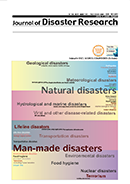Due to language issues, foreign people in Japan encounter more troubles in disasters than do Japanese natives. However, apart from language problems, there are other problems that stem from cultural differences. We also found that foreign residents showed different emergency evacuation and shelter-seeking behaviors from those of the local Japanese residents in the past earthquake. It is necessary to comprehend the emergency evacuation and shelter-seeking behaviors of foreign nationals and indicate their evacuation sites in order to explore useful ways to improve prevention and support work for foreign residents in times of disaster. On 14 April 2016 at 9:26 pm, a 6.5-magnitude earthquake struck in the Kumamoto, Japan area, followed by a second 7.3-magnitude earthquake on 16 April 2016 at 1:25 am. The two earthquakes impacted Kumamoto Prefecture, the area hardest hit by these earthquakes. In this study, we interviewed the foreign residents who experienced the Kumamoto Earthquake in order to examine their emergency evacuation and shelter-seeking behaviors and evacuation sites. We found the emergency evacuation and shelter-seeking behaviors of foreigners to differ depending on why they were in Japan. We found that foreigners living in Kumamoto Prefecture, including permanent residents, spouses of Japanese, and others, are likely to evacuate to locations within Kumamoto Prefecture, and their emergency evacuation and shelter-seeking behaviors are very similar to those of local Japanese natives. Many of the foreigners who come to Japan for work or study tend to evacuate out to locations outside of Kumamoto Prefecture or to even return to their home countries. However, immediately after the earthquake, they evacuate to parks near their residences, to parking lots, to universities, or to other facilities that are used on a daily basis. We also showed the possibility of foreigners taking various emergency evacuation and sheltering actions, and we presented the unique problems of foreigners, including loneliness in evacuation centers and language issues. In addition, we examined evacuation sites (universities, churches, international exchange halls, etc.) where foreigners gathered apart from the designated evacuation shelters in local areas. We also studied the users of these facilities/organizations as well as the actual conditions of support activities. We presented the characteristics of facilities and places that can serve as bases for supporting foreigners. Although these results can not represent all foreigners, we hope the results of this research will become the basic data from which to extract candidates for support sites. Understanding such places and facilities before disaster strikes is considered useful in making support plans for foreigners.
View full abstract
